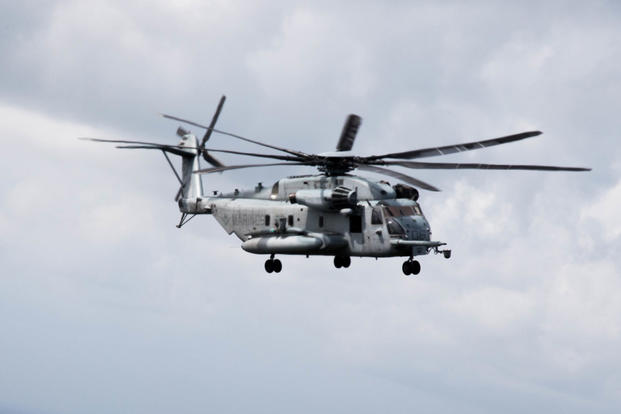Six days after a Marine Corps CH-53E Super Stallion caught fire in flight over Okinawa and was forced to land in a civilian-owned field, the aircraft have resumed normal flight operations, according to III Marine Expeditionary Force.
The development comes as tensions in Okinawa intensify over continued Marine Corps aviation activities and fears for the safety of residents.
The Japan Times reports the Super Stallion, which landed Oct. 11 near Okinawa's Northern Training Area, came down only a few hundred meters away from civilian homes. No Marines or civilians were injured, but some civilian property was destroyed.
The outlet reports that the Okinawa Prefectural Assembly adopted a unanimous resolution on Monday protesting use of helipads in the Northern Training Area, which increases air traffic near Okinawan housing.
"It was a great shock to Okinawa residents, who are forced to live alongside military bases," the resolution held, according to the Japan Times. "The anxiety and fear of the residents are immeasurable."
Officials with III MEF said the governments of Japan and the Okinawa prefecture were notified of the Corps' decision to resume normal flights following the crash.
During the five-day pause, aviation experts reviewed maintenance and inspection records and found nothing abnormal, officials said.
The commanding general for III MEF and Marine Corps Forces Japan, Lt. Gen. Lawrence Nicholson, was satisfied the Super Stallions could continue safe flight operations, the command said.
"We are committed to the safety of flight for all USMC aviation assets in Japan. We take the safety of our aircrews and the citizens of Okinawa seriously," Nicholson said in a statement.
"I would never allow an aircrew to operate an aircraft that I thought was unsafe," he continued. "The CH-53E is a reliable aircraft that has served this Alliance successfully for many decades here on Okinawa and in mainland Japan."
It's the second time in fewer than 12 months that the Marine Corps has been forced to pause flight operations for an airframe in Okinawa after a major incident.
In December 2016, a V-22 Osprey crash-landed in water off Okinawa. While some of the five crew members sustained injuries, all survived the crash.
The Marine Corps conducted an operational pause for a little less than a week following the crash.
Some Okinawans have long viewed the Marines' use of the Osprey in the region with suspicion, citing the aircraft's checkered safety record in its early years of development.
"It is very important for Japanese citizens to understand and share our utmost confidence in the safety and reliability of the MV-22, or we would not continue flight operations," Nicholson said at the time.
"It is equally important that we ensure our pilots have every opportunity to conduct training, which allows us to remain proficient, and enable us to respond when most needed in support of the alliance," he added.
According to III MEF officials, work to salvage the burned wreckage of the CH-53 continues in concert with the government of Japan and local officials.
"We will continue to share information with the government of Japan as details become available and in accordance with the Status of Forces Agreement," they said in a statement.
-- Hope Hodge Seck can be reached at hope.seck@military.com. Follow her on Twitter at @HopeSeck.





























